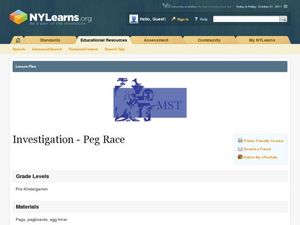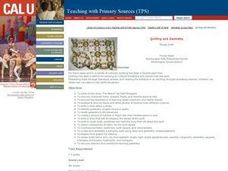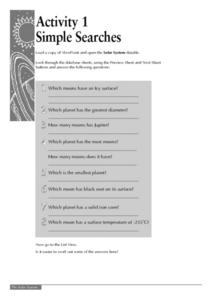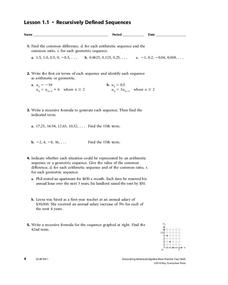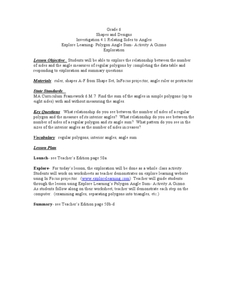Curated OER
TAKS 3rd Grade Upkeep 3
In this TAKS worksheet, 4th graders identify patterns, determine the best operation, and plot numbers on a number line. The three questions pertain to objectives covered on the Texas state test. This would be good bellwork.
Curated OER
Investigation: Peg Race
Students explore competition by participating in a peg race. In this pattern creation lesson, students utilize an egg timer and pegs or colored cubes to create patterns quickly while competing with fellow classmates to finish first....
Curated OER
Exploring Infinite Sequences, Part II
In this algebra worksheet, students identify the nth term of the sequence. They find the missing term in the pattern and what theorem justifies their choice. There are 12 questions.
Curated OER
College Calculus
In this college level Calculus worksheet, students examine sequences to determine if they are increasing, decreasing, or non monotonic. Students find the sum of series and determine if they diverge. The one page worksheet contains...
Curated OER
Sled Kite Proportions
Students build sled kites. in this kite building instructional activity, students must read directions for kite building and enlarge the proportions of the given kite pattern. Students focus on the angles and line of symmetry in their...
Curated OER
Math: a World of Symmetry
Learners expand their knowledge of quadrilaterals and identify basic symmetrical forms. Over three weeks, they explore the math, application, and discussion of symmetry. After conducting Internet research, students create symmetrical...
Curated OER
Patterns and Matchsticks
In this math patterns learning exercise, students solve 10 problems in which a pattern is made with matchsticks on a grid. Students figure out how many matchsticks it will take to continue the pattern. Students also use simple algebra to...
Curated OER
Divide Decimals by Decimals
In this dividing decimals worksheet, students review and observe examples, continue patterns, and multiply the dividend and divisor in each step by ten, so that the quotients remain the same. Students solve three problems.
Curated OER
Studying Snow and Ice Changes
Students compare the change in snow and ice over a 10 year period. In this environmental science activity, students use the live data on the NASA site to study and compare the monthly snow and ice amounts on a map of the entire Earth. ...
Curated OER
Compound Interest
In this compound interest instructional activity, students solve 3 problems after reading about compound interest. They determine the cost of the Apollo missions, they calculate inflation and the cost it would be to send man to the moon...
Curated OER
Interpreting Graphs
In this algebra worksheet, students interpret graphs using given data and information. They are asked to relate real world scenario using algebraic equations. There are 31 questions with a variety of topics being covered.
Curated OER
Geometry and Quilting
Students create a quilt square for a class quilt using at least three, two-dimensional geometric figures. They research and write a brief description of at least two different quilt patterns that they find. Pupils discuss that quilts are...
Curated OER
Simple Searches
In this space worksheet, young scholars load a copy of ViewPoint and open the Solar System datafile. There they look through database sheets, using the Preview Sheet and Next Sheet buttons and respond to 8 questions. Then students do...
Curated OER
Mandalas, Polygons and Symmetry
Students create a geometric pattern using mandalas, polygons and symmetry. In this geometry lesson, students analyze the mathematics involved in making the mandalas, including the shapes and symmetry. Students create their own mandalas...
Curated OER
Recursively Defined Sequesnces
In this algebra activity, students solve a pattern or sequence using geometric and arithmetic formulas. There are 21 questions on 5 different sections.
Curated OER
Mathematics at the Frontier of Astronomy
Students explore the different types of measurements used in astronomy. In this space science lesson, students explain the relationship between planets' orbits and distance from the sun using Kepler's Laws. They discuss how math aides in...
Curated OER
Himalayan Herds: Fractional Exponential Growth
Students solve problems by identifying exponential growth and decay and differentiating between patterns, relation and functions. In this algebra lesson, students apply concepts of exponential growth to solve problems.
Curated OER
Slopes of Lines
Students examine a graph and relate it to the real world situation it depicts. They investigate changes in an equation and the appearance of a line. They investigate the connection between the graph of a situation and the meaning of the...
Curated OER
Multiplying with Packages and Letters
Students explore multiplication. For this multiplication problem solving lesson, students view a video clip which demonstrates loading a truck with packages. Students fill in a blank array to represent 1"X 2" and the multiples when...
Curated OER
Graphs involving Exponential Functions
In this algebra worksheet, students graph exponential functions and analyze it for growth and decay. There are 9 problems with an answer key.
Curated OER
Statistical Process Control
Students brainstorm items they have that use memory and view Statistical Process Control PowerPoint presentation. They complete Statistical Process Control Simulation/experiment then find the average, range and standard deviation in...
Curated OER
Shapes and Designs
In this shapes and designs worksheet, 10th graders solve and complete 6 different types of problems. First, they fill in the first two columns of the table show with their shapes. Then, students measure the interior angles of each...
Curated OER
Paper Pool
Learners explore ratio and proportion, GCF, and LCM. In this middle school mathematics lesson, students play an interactive Paper Pool game that provides an opportunity to increase their understanding or ratio, proportion, GCF, and LCM....
Pennsylvania Department of Education
Let's Learn Those Facts: Looking Back and Moving Forward
Young scholars participate in an adding game. In this adding numbers lesson, students calculate the sum of the dice and remove a number from their activity sheet. Young scholars who first removes the numbers is the winner.



